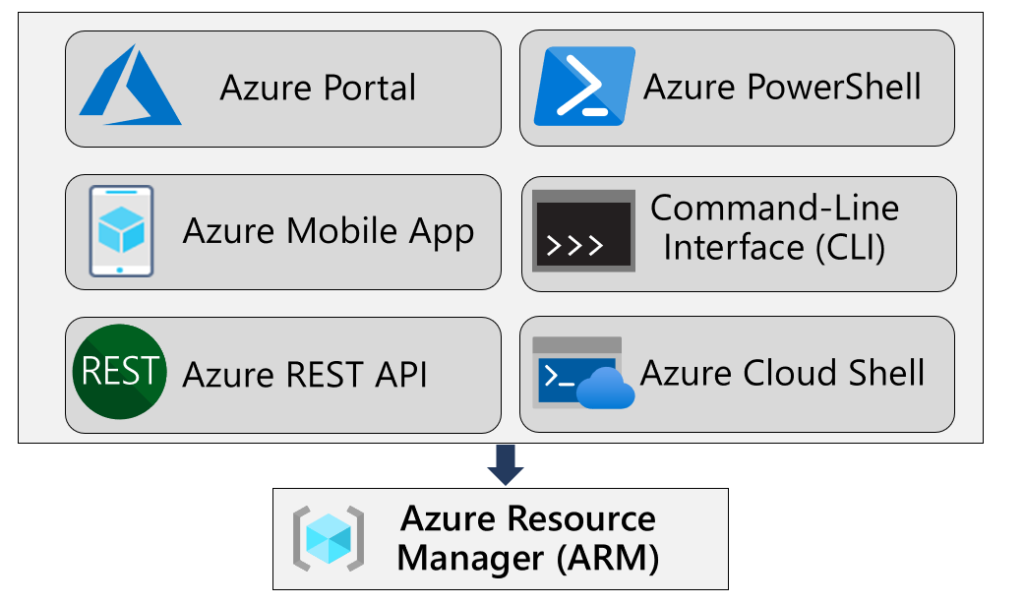Azure Solutions
Internet of Things (IoT) is the ability for devices to garner and then relay information for data analysis.
- Azure IoT Central — is a fully-managed global IoT SaaS solution that makes it easy to connect, monitor, and manage your IoT assets at scale.
- Azure IoT Hub — is a managed service hosted in the cloud that acts as a central message hub for bidirectional communication between your IoT application and the devices it manages.
- Azure IoT Sphere — is a comprehensive IoT security solution—including hardware, OS, and cloud components.
Learn and SkillPipe content:
https://docs.microsoft.com/en-us/learn/modules/iot-fundamentals/1-introduction
https://docs.microsoft.com/en-us/learn/modules/iot-fundamentals/2-identify-product-options
https://docs.microsoft.com/en-us/learn/modules/iot-fundamentals/3-analyze-decision-criteria
https://docs.microsoft.com/en-us/learn/modules/iot-fundamentals/4-use-iot-hub
https://docs.microsoft.com/en-us/learn/modules/iot-fundamentals/5-use-iot-central
https://docs.microsoft.com/en-us/learn/modules/iot-fundamentals/6-use-azure-sphere
Big data and analytics

- Azure Synapse Analytics provides limitless analytics service that brings together enterprise data warehousing and Big Data analytics.
- Azure HDInsight is a fully-managed, open-source analytics service for enterprises. It is a cloud service that makes it easier, faster, and more cost-effective to process massive amounts of data.
- Azure DataBricks is a fast, easy, and collaborative Apache Spark based analytics service.
Artificial Intelligence & Machine Learning
- Azure Machine Learning service provides a cloud-based environment used to develop, train, test, deploy, manage, and track machine learning models.
- Cognitive Services builds intelligent and supported algorithms into apps, websites, and bots to see, hear, speak, understand, and interpret your user needs.
- Azure Bot Service develops intelligent, enterprise-grade bots that let you maintain control of your data.
Learn and SkillPipe content:
https://docs.microsoft.com/en-us/learn/modules/ai-machine-learning-fundamentals/1-introduction
https://docs.microsoft.com/en-us/learn/modules/ai-machine-learning-fundamentals/6-use-bot-services
Serverless Computing
Serverless computing is the evolution of cloud platforms in the direction of pure cloud native code. Serverless brings developers closer to business logic while insulating them from infrastructure concerns. It’s a pattern that doesn’t imply “no server” but rather, “less server.” Serverless code is event-driven. Code may be triggered by anything from a traditional HTTP web request to a timer or the result of uploading a file. The infrastructure behind serverless allows for instant scale to meet elastic demands and offers micro-billing to truly “pay for what you use.” Serverless requires a new way of thinking and approach to building applications and isn’t the right solution for every problem.
- Azure Functions is code running your service and not the underlying platform or infrastructure. Creates infrastructure based on an event.
- Azure Logic Apps is a cloud service that helps you automate and orchestrate tasks, business processes, and workflows when you need to integrate apps, data, systems, and services.
- Azure Event Grid is a fully-managed, intelligent event routing service that uses a publish-subscribe model for uniform event consumption.
Learn and SkillPipe content:
https://docs.microsoft.com/en-us/learn/modules/serverless-fundamentals/1-introduction
https://docs.microsoft.com/en-us/learn/modules/serverless-fundamentals/2-identify-product-options
https://docs.microsoft.com/en-us/learn/modules/serverless-fundamentals/3-analyze-decision-criteria
https://docs.microsoft.com/en-us/learn/modules/serverless-fundamentals/4-use-azure-functions
https://docs.microsoft.com/en-us/learn/modules/serverless-fundamentals/5-use-azure-logic-apps
Develop your apps with DevOps and GitHub
- Azure DevOps services provides development collaboration tools including pipelines, Git repositories, Kanban boards, and extensive automated and cloud-based load testing.
- Azure DevTest Labs allows you to quickly create environments in Azure while minimizing waste and controlling cost.
- GitHub is an American provides hosting for software development and version control using Git. It offers the distributed version control and source code management (SCM) functionality of Git, plus its own features. It provides access control and several collaboration features such as bug tracking, feature requests, task management, and wikis for every project.
- GitHub Actions makes it easy to automate all your software workflows, now with world-class CI/CD. Build, test, and deploy your code right from GitHub. Make code reviews, branch management, and issue triaging work the way you want.
Learn and SkillPipe content:
https://docs.microsoft.com/en-us/learn/modules/azure-devops-devtest-labs/1-introduction
https://docs.microsoft.com/en-us/learn/modules/azure-devops-devtest-labs/2-identify-product-options
https://docs.microsoft.com/en-us/learn/modules/azure-devops-devtest-labs/3-analyze-decision-criteria
https://docs.microsoft.com/en-us/learn/modules/azure-devops-devtest-labs/4-use-azure-devops
https://docs.microsoft.com/en-us/learn/modules/azure-devops-devtest-labs/5-use-github
https://docs.microsoft.com/en-us/learn/modules/azure-devops-devtest-labs/6-use-azure-devtest-labs
Management tools available in Azure

Learn and SkillPipe content:
https://docs.microsoft.com/en-us/learn/modules/management-fundamentals/1-introduction
https://docs.microsoft.com/en-us/learn/modules/management-fundamentals/2-identify-product-options
https://docs.microsoft.com/en-us/learn/modules/management-fundamentals/3-analyze-decision-criteria
https://docs.microsoft.com/en-us/learn/modules/management-fundamentals/4-use-azure-portal
https://docs.microsoft.com/en-us/learn/modules/management-fundamentals/5-use-azure-powershell
https://docs.microsoft.com/en-us/learn/modules/management-fundamentals/6-use-azure-cli
https://docs.microsoft.com/en-us/learn/modules/management-fundamentals/7-use-azure-mobile-app
Azure Advisor
Azure Advisor analyzes deployed Azure resources and makes recommendations based on best practices to optimize Azure deployments.
- Get proactive, actionable, and personalized best practice recommendations.
- Improve the performance, security, and availability of your resources.
- Identify opportunities to reduce your Azure costs.
Learn and SkillPipe content:
https://docs.microsoft.com/en-us/learn/modules/monitoring-fundamentals/1-introduction
https://docs.microsoft.com/en-us/learn/modules/monitoring-fundamentals/2-identify-product-options
https://docs.microsoft.com/en-us/learn/modules/monitoring-fundamentals/3-analyze-decision-criteria
https://docs.microsoft.com/en-us/learn/modules/monitoring-fundamentals/4-use-azure-advisor
https://docs.microsoft.com/en-us/learn/modules/monitoring-fundamentals/5-use-azure-monitor
https://docs.microsoft.com/en-us/learn/modules/monitoring-fundamentals/6-use-azure-service-health
Azure Monitor
Azure Monitor maximizes the availability and performance of applications and services by collecting, analyzing, and acting on telemetry from cloud and on-premises environments.
Learn and SkillPipe content:
https://docs.microsoft.com/en-us/learn/modules/monitoring-fundamentals/1-introduction
https://docs.microsoft.com/en-us/learn/modules/monitoring-fundamentals/2-identify-product-options
https://docs.microsoft.com/en-us/learn/modules/monitoring-fundamentals/3-analyze-decision-criteria
https://docs.microsoft.com/en-us/learn/modules/monitoring-fundamentals/4-use-azure-advisor
https://docs.microsoft.com/en-us/learn/modules/monitoring-fundamentals/5-use-azure-monitor
https://docs.microsoft.com/en-us/learn/modules/monitoring-fundamentals/6-use-azure-service-health
Azure Resource Manager (ARM) templates
Azure Resource Manager (ARM) templates are JavaScript Object Notation (JSON) files that can be used to create and deploy Azure infrastructure without having to write programing commands.

Deploy app resources: Azure Resource Manager enables you to repeatedly deploy your app and have confidence your resources are deployed in a consistent state. You define the infrastructure and dependencies for your app in a single declarative template. This template is flexible enough to use for all of your environments such as test, staging or production. If you create a solution from the Azure Marketplace, the solution will automatically include a template that you can use for your app.
Organize resources: Azure Resource Manager makes it easy for you to manage and visualize resources in your app. You no longer have to deploy parts of your app separately and then manually stitch them together. You put resources with a common lifecycle into a resource group that can be deployed or deleted in a single action. You can see which resources are linked by a dependency. You can apply tags to resources to categorize them for management tasks, such as billing.
Control access to resources: With Azure Resource Manager, you can control who in your organization can perform actions on the resources. You manage permissions by defining roles and adding users or groups to the roles. For critical resources, you can apply an explicit lock that prevents users from deleting or modifying the resource. Azure Resource Manager logs all user actions so you can audit those actions. For each action, the audit log contains information about the user, time, events, and status.
Learn and SkillPipe content:
https://docs.microsoft.com/en-us/learn/modules/monitoring-fundamentals/1-introduction
https://docs.microsoft.com/en-us/learn/modules/monitoring-fundamentals/2-identify-product-options
https://docs.microsoft.com/en-us/learn/modules/monitoring-fundamentals/3-analyze-decision-criteria
https://docs.microsoft.com/en-us/learn/modules/monitoring-fundamentals/4-use-azure-advisor
https://docs.microsoft.com/en-us/learn/modules/monitoring-fundamentals/5-use-azure-monitor
https://docs.microsoft.com/en-us/learn/modules/monitoring-fundamentals/6-use-azure-service-health

